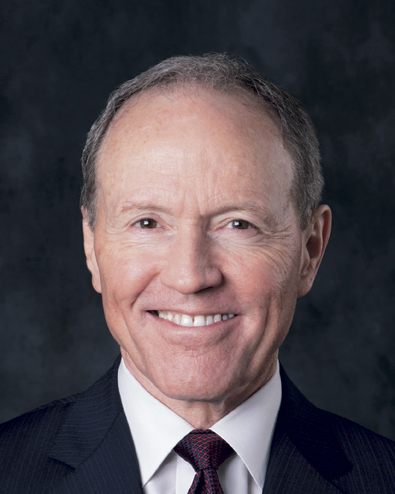FLOOD INSURANCE

FLOOD INSURANCE
Will the private market be big enough to make a big difference?
By Joseph S. Harrington, CPCU
We’ve come to a significant milestone in the troubled history of U.S. flood insurance.
As of July 1, 2019, real estate lenders seeking to sell mortgages to federally sponsored secondary market agencies (Fannie Mae, Freddie Mac, etc.) are required to accept private flood insurance policies on collateral properties, provided those policies conform to federal statutory requirements. As of that date, lenders are also allowed to accept private flood policies that do not conform to those requirements but meet other conditions.

“We encourage simplification across the board to ensure all consumers get the coverage they need, not just the 8% at the highest risk, but the 92% who are exposed to moderate risk.”
—Ralph Blust
CEO
National Flood Services
In short, the federal government is seeking to relax the near-monopoly on residential flood insurance held by the heavily indebted National Flood Insurance Program (NFIP), provided that private coverage is at least equivalent to that provided under NFIP policies.
“This effectively unlocks a $40 billionmarket opportunity, as long as the private policies are as good as or betterthan NFIP,” says Chad LaTour, vice president of emerging markets for NatGen Premier, a division of National General Insurance. “The private flood market has historically been held back by lenders not accepting private flood insurance alternatives.”
Craig Poulton, CEO of Poulton Associates, LLC, which administers a Natural Catastrophe Insurance Program, agrees with that assessment. “The private flood insurance market could be five or ten times larger than it is if federal regulators and the NFIP had not limited insurance producers from transferring NFIP policies to the private market,” Poulton says.
In Poulton’s estimation, the latest changes in federal policy have helped, but haven’t gone far enough to create a completely level playing field for private flood insurers.
“There are still NFIP rules and guidelines that will have the effect of severely impeding the growth of the private market,” he says. “First, the NFIP refuses to allow flood insurance consumers to cancel an NFIP policy midterm and replace it with a private market policy.
“Second, the NFIP continues to use a rating mechanism that subsidizes, at taxpayer expense, about 50% of all NFIP insureds,” he adds. “Finally, the NFIP punishes policyholders who move to the private market and then attempt to return to the NFIP, by allowing only those who remain with the NFIP to maintain their subsidized rates.”

“It will take a number of years before flood models are highly
predictive on the property footprint level. Currently, they can create a more informed underwriting decision, but cannot be relied upon as stand-alone, automatic decisioning tools, except in rare cases.”
—Craig Poulton
CEO
Poulton Associates, LLC
Looking beyond
Whether private insurance can or should supplant government-backed flood insurance in flood zones is only part of the question. Another dimension is the expansion of flood coverage to property owners in flood-stricken areas where flood insurance was not previously thought to be necessary.
“Traditionally the focus of flood coverage by the industry is on the highest risk properties, which represent only 8% of the [residential] market,” says Ralph Blust, CEO of National Flood Services, formerly an Aon company, but acquired in 2018 by the Chicago-based investment firm PEAK6.
“The real opportunity is to alter the focus to the rest of the market and provide appropriate coverage and realistic prices,” Blust says. To capitalize on that opportunity, Blust advises private carriers to simplify their flood insurance applications and related operations, and make them more consistent with those for other types of property coverage.
According to Matt Junge, head ofproperty solutions in the United States and Canada for Swiss Re, primary carriers are showing a lot of interest in providing some level of residential flood coverage, either through stand-alone policies or endorsements to homeowners policies, sometimes but not always to a level equivalent to an NFIP policy.
“A year ago, I would have told you that interest was really great but slow to transition into actual policies,” he says. “In 2019, we’re seeing even more interest, and it’s being acted on as companies create private flood policies or add endorsements to their homeowners and small business policies.”
Junge says Swiss Re has 11 contracts with primary carriers for reinsuring flood coverage for at least 20,000 residences. “It’s still a small market, but interest is spreading and it’s growing very quickly,” he says.
Product innovation
Interest among private carriers is driving new developments in flood insurance policies.
Poulton Associates’ Natural Catastrophe Insurance Program contrasts with NFIP policies in several key respects:
- There is no restriction that a flood needs to inundate a two-acre area, or two adjacent properties, before coverage is triggered
- Coverage is available for loss of use/additional living expenses
- Coverage is available for debris removal and personal property below ground level
In addition, the Poulton program allows for a shorter waiting period, higher limits, and replacement cost coverage for personal property under a single policy that can cover multiple buildings, which can save the policyholder on premium.
For its part, National General plans to offer an admitted stand-alone private flood policy with multiple options for broadened coverage, including coverage for replacement cost, loss of use, basement contents, and pool clean-up, plus options for additional limits (in lieu of sub-limits) and flexible payments.
Some private flood initiatives are only enhancements to homeowners insurance policies, and do not seek to provide the level of coverage needed for policies covering mortgaged properties in flood zones, says Junge.
“Some companies say they don’t want to have anything to do with competing with the NFIP,” he says. “There’s so much opportunity out there for private flood coverage that they just offer it under a lower sub-limit in a property policy.
“We see a number of insurance companies including a quote for flood coverage with every homeowners quote they prepare,” he says. “Whether it’s $25,000 or $100,000 or something else really depends on whether a primary carrier adds the coverage for the full policy limit or for a sub-limit.”

“In 2019, we’re seeing even more interest (in flood coverage), and it’s being acted on as companies create private flood policies or add endorsements to their homeowners and small business policies.”
—Matt Junge
Head of Property Solutions, United States and Canada
Swiss Re
Technology and modeling
Proponents of private flood insurance base their bullish estimates for its potential on the rapidly growing sophistication of modern technologies and predictive models.
“Advances in modeling are having a major positive impact on the industry,” says Blust. “Advances in technology and predictive analytics allow for more precise evaluation of risks at the structure and property level, as opposed to geographical characteristics, which were utilized in the past.”
Developments in three areas account for the improvements in flood modeling, according to Junge: advancements in hydrology (the physics of water flow in essence); advances in mapping (including detection of small variations in elevation); and the exponential growth in computing power that allows models to be quickly developed, tested, and refined.
There is still a way to go, however.
“Flood models are influencing the insurability of the flood peril, but so far, the impact on highly granular risk assessment has not been dramatic,” says Poulton. “It will take a number of years before flood models are highly predictive on the property footprint level. Currently, they can create a more informed underwriting decision, but cannot be relied upon as stand-alone, automatic decisioning tools, except in rare cases.”
“Given the scale and magnitude of changes in climate trends, many models in use today can’t yet give a complete and reliable picture of flood risk,” says LaTour. “For the same address with the same inputs, some modeling companies will return predicted loss results that are orders of magnitude different from each other.”
Progress is happening, however, andto support its own private flood products, National General announced in June 2019 that it had acquired Syndeste, an insurtech startup that developed and maintains its proprietary “Beyond Floods” underwriting platform.
Adverse selection?
Like most current flood models, Beyond Floods promotes “high resolution data and insights on flood risk.” As flood models get better at predicting impact on precise locations, could that create new problems for insurers?
Because of how water flows, flooding is arguably the most localized natural peril insurers face. As Junge explains, “higher resolution” means that the risk of flood loss varies greatly within small areas, measured in feet and meters, due to the relative elevation of adjacent or nearby properties.
In contrast, the location and intensity of windstorms and earthquakes occur randomly; their impact can only be estimated for larger areas, measured in miles. Thus, property owners in a hurricane- or earthquake-prone area have an incentive to share the risk for those hazards (not that they always do).
Highly precise assessments of flood exposure could create a problem of adverse selection. Owners of properties that are relatively elevated, even by only a foot or so, may have little incentive to buy coverage and share the risk faced by a low-lying neighbor. If rates are developed on a strictly actuarial basis, that neighbor may then find its flood premium to be unaffordable.
While National General has invested in an acquisition of a hazard modeling firm, LaTour adds that “models cannot inherently make the risk more insurable, as there is no out-of-the-box answer to underwriting flood.”

“Models cannot inherently make the risk more insurable, as there is no out-of-the-box answer to underwriting flood.”
—Chad LaTour
Vice President of Emerging Markets
NatGen Premier
What now?
It appears that fewer Americans in high-risk areas are buying flood insurance.
According to a report in The New York Times, the number of NFIP policies in states ravaged by 2019 floods near the Missouri River dropped by at least one-third between 2011 and 2018. In three affected states—Illinois, Missouri, and Nebraska—15% or fewer homes in floodplains have federal flood coverage.
Looking forward, Poulton says that further reforms to the NFIP will take the country “about 75% to 80%” of the way to a “comprehensive solution” to the nation’s flood insurance shortfall. “Increase the size of flood zones, force the NFIP to raise rates to an actuarial level, and force the NFIP to share loss data with private insurers,” he says.
Regarding the last, the Federal Emergency Management Agency (FEMA), which administers the NFIP, published data in mid-June on more than two million NFIP claims records dating back to 1978, plus data on more than 47 million policy transaction records over the past 10 years.
In its announcement, FEMA explicitly cited a desire to promote development of a private flood insurance market. David Maurstad, FEMA’s deputy associate administrator for insurance and mitigation, says that “the private market will now be able to identify areas with prior flood claims and historical flood insurance policies.”
States and localities have a role to play, as well.
“State regulators are learning about flood and accepting private flood [rate and form] filings,” says LaTour. “Some states welcome the introduction of a private flood program. We have been encouraged by the progressive view that some states have taken in regards to regulating private flood. They understand that when the only policy historically available has been through the NFIP, they cannot view the product through the standard P-C lens.”
As for local governments, LaTour recommends that they “educate their constituents about the protection gap for flood through community-level initiatives, including support for a private flood marketplace where home owners and business owners can access private alternatives to the NFIP.”
“States are generally supportive of the private development of flood products,” says Blust. “However, most flood products are developed in excess and surplus lines, beyond the oversight of the states. I think that must change.
“We encourage simplification across the board to ensure all consumers get the coverage they need, not just the 8% at the highest risk, but the 92% who are exposed to moderate risk,” he adds. “The NFIP and private insurers working alongside each other will provide the best offerings to consumers.”
For more information:
NatGen Premier
www.natgenpremier.com
National Flood Services
www.nationalfloodservices.com
Poulton Associates, LLC
www.poulton.com
Swiss Re
www.swissre.com
The author
Joseph S. Harrington, CPCU, is an independent business writer specializing in property and casualty insurance coverages and operations. For 21 years, Joe was the communications director for the American Association of Insurance Services (AAIS), a P-C advisory organization. Prior to that, Joe worked in journalism and as a reporter and editor in financial services.











